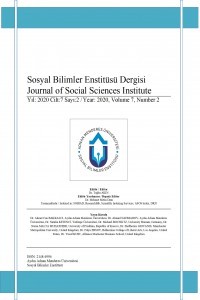Mevsimsel Değişkenliklerin Borsa İstanbul Üzerindeki Oynaklık Etkisi: Ramazan Ayı Örneği
Hisse Senetleri Getirisi, Takvimsel Oynaklık, Ramazan Etkisi
Volatility Effect of Seasonal Variation on Borsa Istanbul: The Ramadan Case
Stock Returns, Calendar Anomaly, Ramadan Effect,
___
- ADEBIYI, A.A., ADEWUMI, A.O. and AYO, C. (2014). Stock Price Prediction Using the ARIMA Model, In Computer Modelling and Simulation (UKSim), 2014 UKSim-AMSS 16th International Conference on (pp. 106-112). IEEE.
- AHKING, F. (2001). Model Mis-Specification and Johansen’s Co-Integration Analysis: An Application to The US Money Demand. Journal of Macroeconomics, 24 (2002), 51–66.
- AL-HAJIEH, H., REDHEAD, K. and RODGERS, T. (2011). Investor Sentiment and Calendar Anomaly Effects: A Case Study of The Impact of Ramadan on Islamic Middle Eastern Markets. Research in International Business and Finance. 25 (2011): 345-356.
- Başarır, Ç. and ERÇAKAR, M. E. (2016). An Analysis of the Relationship Between Crude Oil Prices, Current Account Deficit and Exchange Rate. International Journal of Economics and Finance, 8 (11).
- BERUMENT, H., INAMLIK, A. and KIYMAZ, H. (2004). The Day of the Week Effect on Stock Market Volatility: Istanbul Stock Exchange. http://berument.bilkent.edu.tr/iif05.pdf (Erişim tarihi:19.05.2017)
- BODIE, Z., KANE, A. and MARCUS, A.J. (2014). Investments. 10th Ed. McGraw Hill: UK.
- BOLLERSLEV, T., (1986). Generalized Autoregressive Conditional Heteroskedasticity (GARCH). Journal of Econometrics, 31, 307–327.
- DECARLO, L. T. (1997). On the Meaning and Use of Kurtosis, Psychological Method. American Psychological Association, 2 (3), 292-307.
- DOANE, P.D. and SEWARD, E. L. (2011). Measuring Skewness: A Forgotten Statistic? Journal of Statistics Education, 19 (2).
- EJDER, U. (2011). Multivariate Garch Models, İstanbul Technical University Informatics Institute, M. Sc. Thesis, Department of Informatics Computational Science and Engineering Programme, August 2011.
- ENGLE, R. (2014), GARCH 101: An Introduction to the Use of ARCH/GARCH models in Applied Econometrics, http://www.stern.nyu.edu/rengle/GARCH101.PDF (Erişim tarihi: 20.05.2017)
- ENGLE, R. (2002), An Introduction to the Use of ARCH/GARCH models in Applied Econometrics, http://www.stern.nyu.edu/rengle/GARCH101.PDF (Erişim tarihi: 20.05.2017)
- ENGLE, R. (1982). Autoregressive Conditional Heteroskedasticity with Estimates of the Variance of United Kingdom Inflation. Econometrica, 50, 987–1007.
- FRYZLEWICZ, P. (2007). Lecture Notes: Financial Time Series, ARCH and GARCH Models, http://stats.lse.ac.uk/fryzlewicz/lec_notes/garch.pdf (Erişim tarihi: 20.05.2017).
- GAVRIILIDIS, K., KALLINTERAKIS, V. and TSALAVOUTAS, I. (2015). Investor Mood Herding and the Ramadan Effect. http://ssrn.com/abstract=2568699 (Erişim tarihi: 19.5.2017).
- GUJARATI, D. (2004). Basic Econometrics, Fourth Edition, The McGraw−Hill Companies, 2004.
- HUSAIN, F. (1998). A Seasonality in the Pakistani Equity Market: The Ramadhan Effect. The Pakistan Development Review. 37 (1): 77-81.
- IŞIK, N., ACAR, M. and IŞIK, H. B. (2004). Relationship Between Inflation and Exchange Rate; A Cointegration Analysis. Süleyman Demirel University Journal of Faculty of Economics and Administrative Sciences, 9 (2), 325-340.
- KHAZALİ, O.A. (2014). Revisiting Fast Profit Investor Sentiment and Stock Returns During Ramadan. International Review of Financial Analysis, 33 (2014), 158-170.
- LATIF, M., ARSHAD, S., FATIMA, M. and FAROOQ, S. (2011). Market Efficiency, Market Anomalies, Causes, Evidences, and Some Behavioral Aspects of Market Anomalies. Research Journal of Finance and Accounting. 2 (9).
- MONDAL, P., LABANI, S. and SAPTARSI G. (2014), Study of Effectiveness of Time Series Modeling (Arima) In Forecasting Stock Prices. International Journal of Computer Science, Engineering and Applications (IJCSEA), 4 (2), April 2014.
- OGUZSOY, C.B. and GUVEN, S. (2004). Holy Days Effect on Istanbul Stock Exchange. Journal of Emerging Market Finance. 3 (1): 63-75.
- OLGUN, O. (2007). The Day of the Week Effect in Istanbul Stock Exchange During 1988-2006. Third International Student Conference. Izmir, Turkey.
- RAMEZANI, A., POURAGHAJAN, A. and MARDANI, H. (2013). Studying Impact of Ramadan on Stock Exchange Index: A Case of Iran. World of Sciences Journal. 1 (12): 46-54.
- SEYYED, F.J., ABRAHAM, A. and AL-HAJJI, M. (2005). Seasonality in Stock Returns and Volatility: The Ramadan Effect. Research in International Business and Finance. 19 (2005): 374-383.
- TERASVIRTA, T. (2006). An Introduction to Univariate GARCH Models. SSE/EFI Working Papers in Economics and Finance, 646, December 7, 2006.
- VOGLVANG, B. (2005). Econometrics Theory and Applications with E Views, Prentice Hall Financial Times, Pearson Education Limited 2005.
- WANG, W., VAN GELDER, P.H.A.J.M., VRIJLING, J.K. and MA, J. (2005). Testing and Modelling Autoregressive Conditional Heteroskedasticity Of Streamflow Processes, Nonlinear Processes in Geophysics (2005), European Geosciences Union.
- Yayın Aralığı: Yılda 2 Sayı
- Başlangıç: 2014
- Yayıncı: Aydın Adnan Menderes Üniversitesi
Sosyal Güvenlik Kurumları Açısından İllerin Analizi: MOORA Yöntemi
Ersin YAVUZ, Tahsin AVCI, Abdullah Emre ÇAĞLAR
Mevsimsel Değişkenliklerin Borsa İstanbul Üzerindeki Oynaklık Etkisi: Ramazan Ayı Örneği
Alper Yılmaz, Zeliha Can Ergün
Güvenlik Politikalarının Konstrüktivist Bir Unsuru Olarak Güvenlik Kültürü ve Türkiye Örneği
Fikret Birdişli, Aynur Başurgan
Yaşlı Yoksulluğunun Yarattığı Sosyal ve Psikolojik Sorunlar: Muğla Örneği
Mevlüde Türkan, Sergender SEZER
E-Wom’un Tüketicilerin Tatil Satın Alma Niyetine Etkisi
Fatma Çakır, Nurhan Aybar, Gökhan Akel
Türkiye Kamu Yönetiminde Yönetişim Algisi: Aydin İli Vergi Dairelerinde Bir Uygulama
Mükelleflerin Özel Tüketim Vergisinde Yapılan Değişikliklere Tepkileri
İşıl AYAS, Cahit ŞANVER, Nihayet Mehtap TOPALFAKIOĞLU
Geçiş Ekonomilerinde Gelir Eşitsizliği ve Ekonomik Sistem İlişkisi
